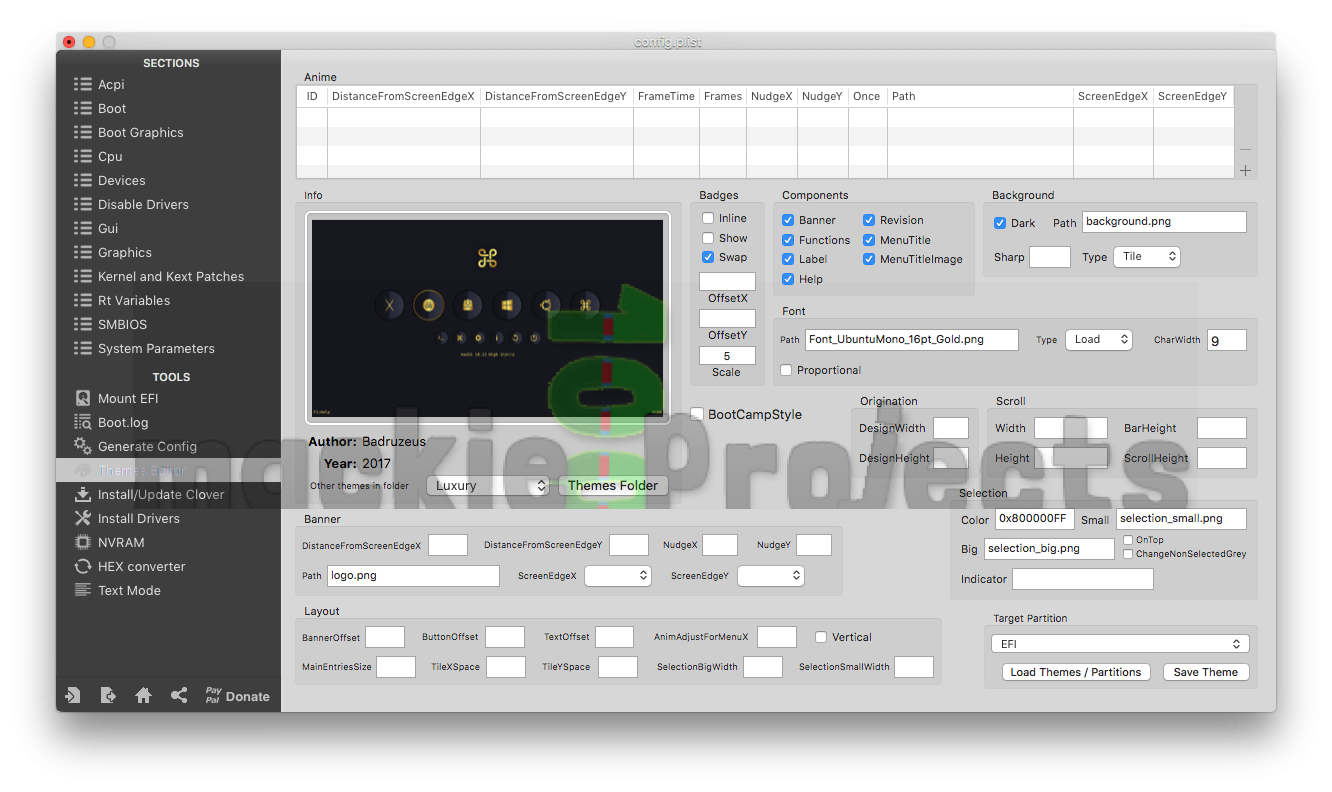

- #CLOVER CONFIGURATOR EL CAPITAN INSTALL#
- #CLOVER CONFIGURATOR EL CAPITAN DRIVER#
- #CLOVER CONFIGURATOR EL CAPITAN WINDOWS#
There is no specific order for flags so they can be placed anywhere. You can enter such flags as -v for verbose mode where you can see all items loading line by line, or even -x to boot into safe mode for example. Use the arrow keys to navigate the cursor on the line. To make any changes (in this line or any other lines), highlight it, then press Enter, then start typing. Boot Args: Here's where the arguments and boot flags go. Config: This is the filename for the configuration list. When you're in a submenu you can select another line, press Enter/Return to make changes, then press Escape or highlight Return and press enter/Return to go back to the previous screen. To select an option, use the up/down arrow keys and press Enter/Return to select.

This presents you with a plethora of booting options. To make any changes to the boot, highlight Options and press Enter or Return.
#CLOVER CONFIGURATOR EL CAPITAN WINDOWS#
If your system is set to dual-boot, you can select Exit Clover to boot from your Windows hard drive if you have a Windows system installed. Selecting About will take you to a screen showing the current version and developer credits, Restart will restart your computer, and Exit Clover will take you out of the Clover screen. Here the main hard drive and recovery partition are shown, while below you will see four icons for Options, About, Restart, and Exit Clover, respectively. I can use the arrow keys on the keyboard to select the items from left to right. When I turn the laptop on I am greeted with the following screen after only a few seconds:

The laptop consists of a 120 GB SSD with Windows, and a 120 GB SSD with OS X where the DVD drive used to be. You can make a note of the SMBIOS used, then use CloverConfigurator to select the same SMBIOS and save it to the ist file.īelow is a screenshot of Clover taken from my hackbook. Moments like this may require you to repeat the process but stop at Clover's main screen (where you select the hard drive or other options), then go into Options and try different SMBIOS settings so you can at least get to the splash screen of the OS X installer. Or it may show that items are loading but the screen freezes and the computer restarts. For example, you may boot using UniBeast, boot into Clover, select the UniBeast flash drive and only get a black screen. While you may have to make changes in Clover when installing OS X, these same changes should be reflected to the target drive after installation using Clover Configurator. Once saved, create a folder on your OS X installer flash drive such as “Extra Software” and copy the Clover configurator installer to that location so that modifications and changes can be made quickly.Ĭlover is used much like Chimera where you can modify settings in the installer (UniBeast) and the target drive after installation has taken place. Once you have OS X installed, you can use Clover Configurator to change the boot settings and stabilize your hackintosh or hackbook. Clover Configurator can be downloaded from.
#CLOVER CONFIGURATOR EL CAPITAN INSTALL#
Clover comes with UniBeast so you'll have it installed when you install OS X, but stabilizing OS X requires the use of Clover Configurator. It's menu-driven with multiple entries for different sections and doesn't rely on the cryptic flags commonly used by Chimera. While the learning curve is a little steep, it may be somewhat quick to catch on to, and some of the old flags in Chimera will still work. Instead you'll start using a bootloader called Clover. Starting with OS X 10.11 (El Capitan), the old bootloader Chimera no longer works. NEW SECTION: Using Clover and Clover Configurator With Apple's latest OS starting from Sierra (10.12), the same flag is no longer required when using the bootloader Clover. Once everything was installed, I didn't need to use it again.
#CLOVER CONFIGURATOR EL CAPITAN DRIVER#
Note: To get any video on my current Gigabyte GTX 960 graphics card from an initial installation, I had to boot with the flag “nv_disable=1” repeatedly after updating OS X, other drivers, and switching from Apple's built-in driver to Nvidia's web driver. If there are drastic changes that require different steps, these will be updated accordingly. This should be updated to "" as the procedures are generally the same with each version. Some of the sentences refer to a previous version of OS X, generally Yosemite or Mavericks.


 0 kommentar(er)
0 kommentar(er)
